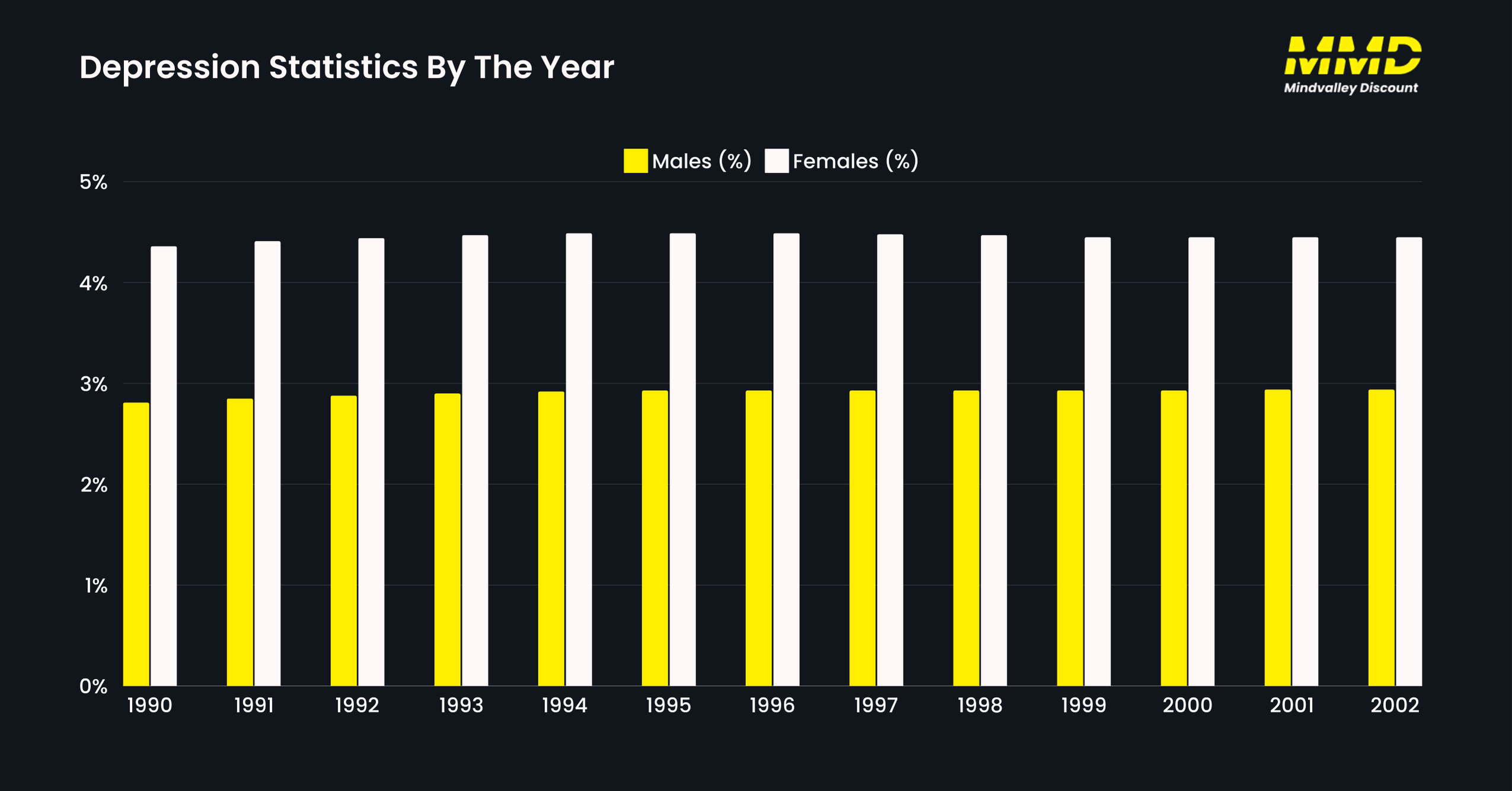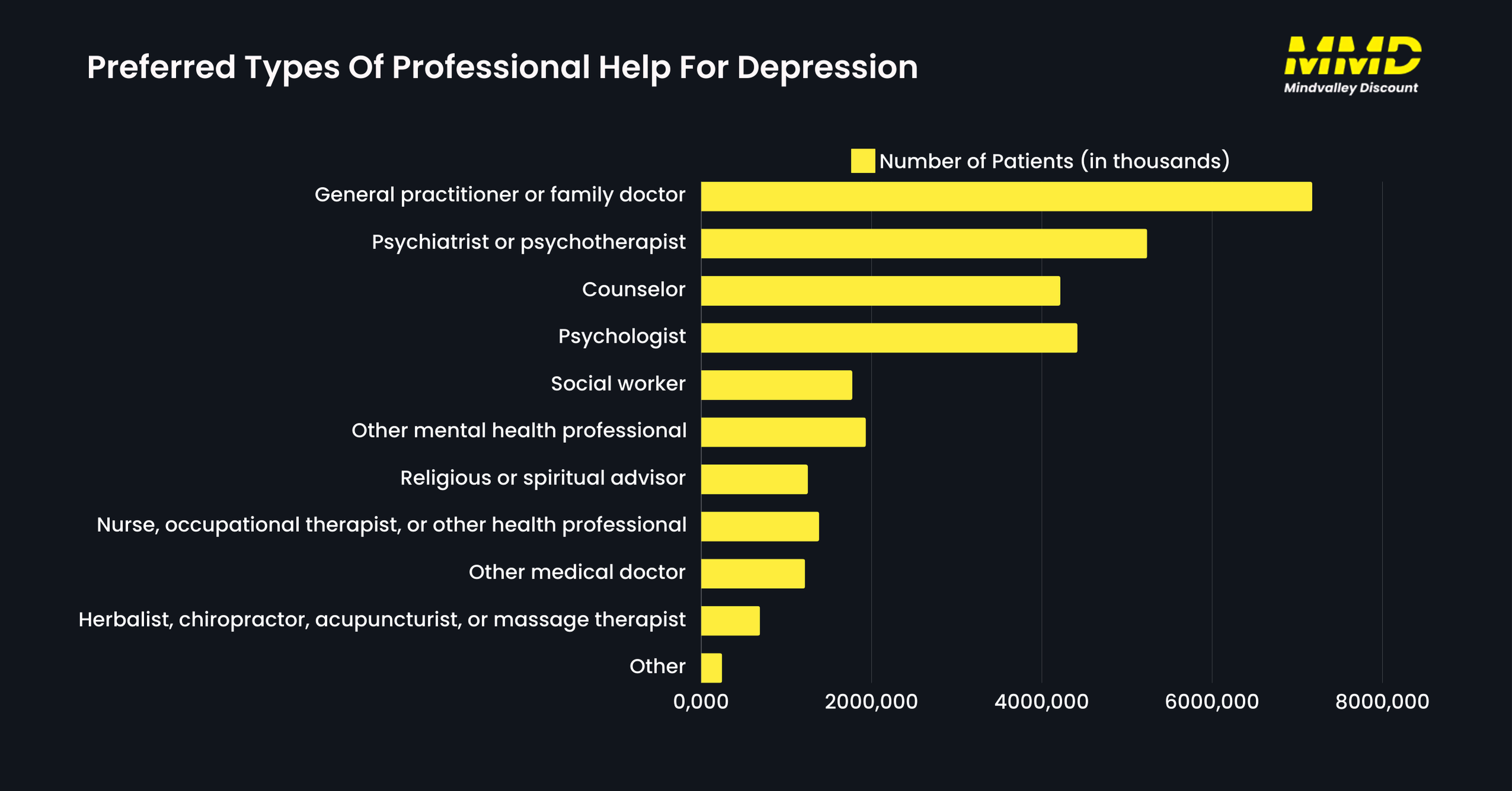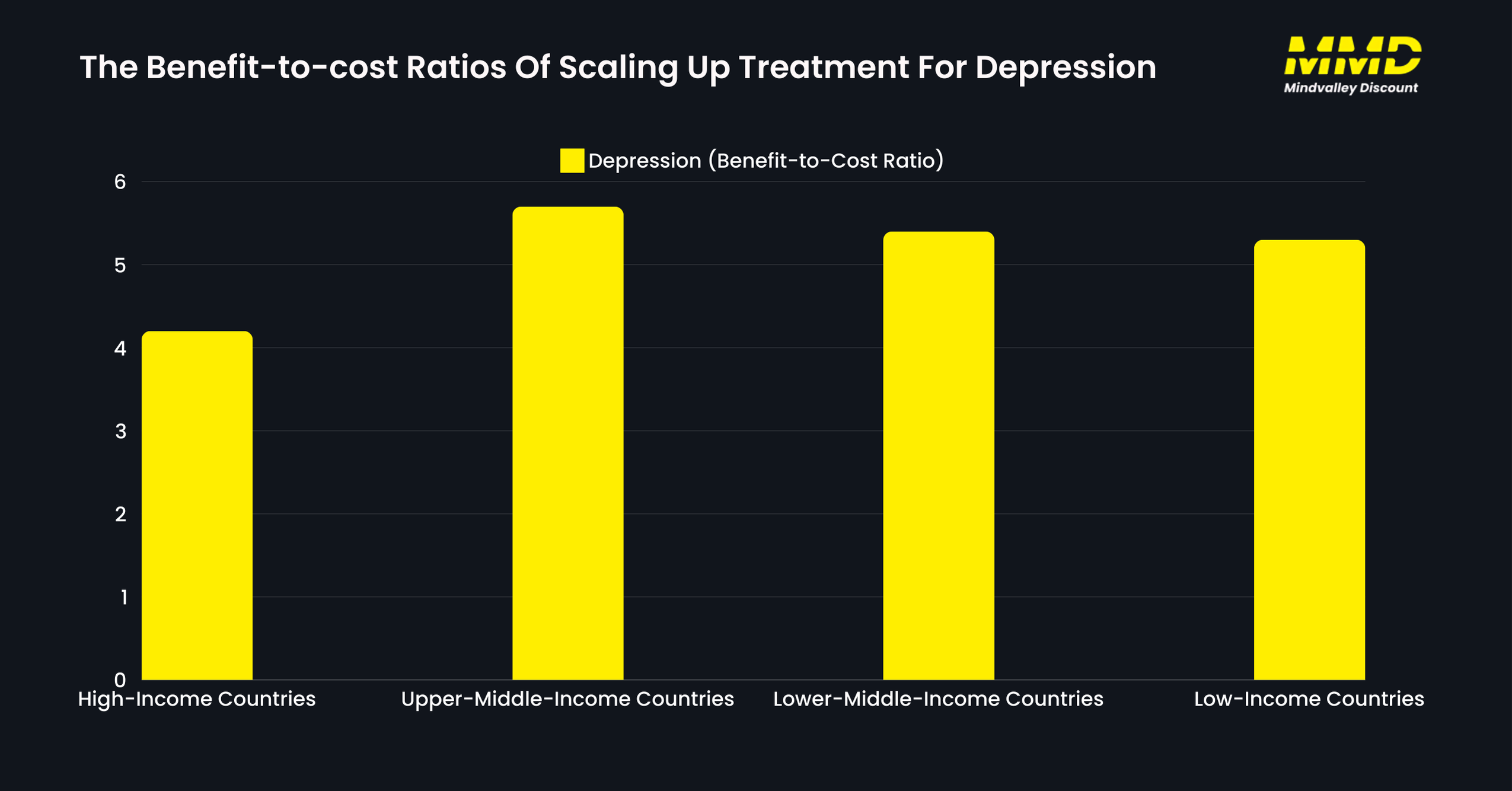Depression contributes significantly to increased mortality, morbidity, and disability, affecting not only individuals but also families and society as a whole.
It has detrimental effects on both occupational and interpersonal functioning, with substantial costs associated with lost workdays due to depressive symptoms.
Furthermore, depression is linked to a heightened risk of various physical health conditions, including cardiac illness, diabetes, and hypertension.
But to what extent has depression affected people globally? Let us find out!
Top Picks: Depression On Statistics
- Depression is the 2nd most common mental disorder globally, the first being Anxiety disorder and 3rd being bipolar disorder.
- As per the latest study conducted in 2019, 280 million people were living with depression, including 23 million children and adolescents. (Source- WHO)
- Worldwide, more than 10% of pregnant women and women who have just given birth experience depression. (Source- WHO)
- A significant portion of those affected do not receive adequate care. The estimated coverage rate of 40% (only about two-fifths) of individuals diagnosed with depression are receiving adequate treatment.
- In 2020, 80% of the countries that responded reported that care and treatment for specific mental health conditions (including depression) were included in national health insurance or reimbursement schemes. This reflects an increase from 73% in 2017.
The percentage of countries that excluded mental health conditions from insurance schemes decreased significantly, from 44% in 2017 to 19% in 2020.
The percentage of countries reporting no inclusion of mental health conditions, such as depression, in national insurance schemes declined from 27% in 2017 to 20% in 2020.
The percentage of countries that explicitly listed mental health conditions, such as depression, as included conditions in insurance schemes increased from 68% in 2017 to 74% in 2020. (Source- WHO)
- 1 in every 4 people who develop epilepsy will also develop depression or anxiety. (Source- WHO)
Depression Statistics By The Year
- Between 1990 and 2002, both males and females saw a slight increase in depression rates. The male percentage increased from 2.81% in 1990 to 2.94% in 2002. Similarly, for females, it rose from 4.36% to 4.45%.

The table below shows these depression rates show trends over time:
| Year | Males (%) | Females (%) |
|---|---|---|
| 1990 | 2.81% | 4.36% |
| 1991 | 2.85% | 4.41% |
| 1992 | 2.88% | 4.44% |
| 1993 | 2.9% | 4.47% |
| 1994 | 2.92% | 4.49% |
| 1995 | 2.93% | 4.49% |
| 1996 | 2.93% | 4.49% |
| 1997 | 2.93% | 4.48% |
| 1998 | 2.93% | 4.47% |
| 1999 | 2.93% | 4.45% |
| 2000 | 2.93% | 4.45% |
| 2001 | 2.94% | 4.45% |
| 2002 | 2.94% | 4.45% |
(Source- Statista)
Depression Statistics By Country
- 72.8% of respondents experienced depressive symptoms in 2023 in Poland, up 11.4 percentage points from 2022. (Source- Statista)
- In Spain, over 2.4 million cases of depression or depressive disorder were registered in 2022, up from 479,500 in 2011. (Source- Statista)
- In France, from 2020 to 2022, 14% of males and 18.3% of females suffered from depression. (Source- Statista)
- Among individuals aged 18 to 24, 15.7% of men and 18.7% of women reported experiencing depression in the Netherlands in the year 2022. (Source- Statista)
- As of 2022, the United Kingdom (19%) had the highest depression rate in Europe, followed by Italy (18%) and Germany(18%).
The prevalence of depression varies significantly across different European countries:
| European Countries | Depression |
|---|---|
| Ireland | 17% |
| United Kingdom | 19% |
| Italy | 18% |
| Germany | 18% |
| Spain | 17% |
| Belgium | 16% |
| Switzerland | 12% |
| France | 13% |
(Source- Statista)
- The Vidarbha Stress and Health Program (VISHRAM) by Sangathan in India reduced depression prevalence by 22% and increased mental health care-seeking behavior six-fold, significantly improving community awareness in rural India.
- Since 2014, the Pursukoon Zindagi program in Pakistan has screened over 100,000 individuals for anxiety and depression, providing free mental health counseling to more than 9,000 people and enhancing community awareness.
- In Uganda and Zambia, StrongMinds trains lay workers to provide culturally adapted therapy for depression and helped over 100,000 individuals, with 80% recovering and sustained improvements in social and economic well-being.
- In Nepal’s Chitwan district, the mhGAP initiative improved depression treatment coverage from 0% to 12%. This training for non-specialists enhanced community access and effective psychological care for individuals experiencing depression.
Similarly, In Türkiye, the mhGAP program trained nearly 2,600 primary care providers to address mental health needs. Over 1,000 people with depression accessed these services.
(Source- WHO)
Depression Statistics In The U.S
- As of 2022, approximately 22% of U.S. adults experience clinical depression, marked by prolonged sadness and hopelessness affecting daily activities.
Keeping with the global trend, depression in the US is more prevalent in women (6%) than in men (3.5%), with young adults (18-25) experiencing the highest rates of major depressive episodes.
Among teenagers, approximately 28% of girls and 11.5% of boys reported a major depressive episode in 2022.
- Depression is a significant risk factor for suicide; in 2020, about 73% of suicide victims in the USA had depression.
(Source- Statista) - 12,806 U.S. adults with a major depressive episode received treatment in 2022.

Here is a breakdown of the types of professional help Americans preferred to treat depression in 2022:
| Type Of Professional | Number Of Patients (In Thousands) |
|---|---|
| General practitioner or family doctor | 7,175 |
| Psychiatrist or psychotherapist | 5,237 |
| Counselor | 4,217 |
| Psychologist | 4,418 |
| Social worker | 1,774 |
| Other mental health professional | 1,933 |
| Religious or spiritual advisor | 1,252 |
| Nurse, occupational therapist, or other health professional | 1,384 |
| Other medical doctor | 1,219 |
| Herbalist, chiropractor, acupuncturist, or massage therapist | 690 |
| Other | 245 |
| Total | 12,806 |
(Source- Statista)
Depression Statistics By Demographics
- Females and younger individuals, mainly those aged 20–24 years, experienced higher rates of depression during the pandemic compared to older adults.
- Studies indicated that approximately 25% of children experienced elevated levels of depression during the pandemic, with symptoms more pronounced in older children and girls. (Source- Medbox)
Students can develop better coping mechanisms to enhance mental health and reduce depression. You can access a Mindvalley student discount to start building healthy habits.
- Gender differences in rates of depression are narrowing in countries as the roles of men and women become the same. (Source- WHO)
- Depressive and anxiety disorders are about 50% more common among women than men throughout the life course, while men are more likely to have substance use disorder.
- Adults with chronic diseases are 2 or 3 three times more likely to develop depression than the rest of the population.
- Individuals with heart disease are more than twice as likely to suffer from depression or anxiety than those who do not have heart disease.
- 1 in 2 people with leprosy or lymphatic filariasis experiences depression or anxiety.
- In people with lymphatic filariasis, depression has been estimated almost to double the total burden of the disease.
- Prisoners face significantly higher rates of depression than the general population, with estimates showing 16% of incarcerated individuals affected. This rate is six times higher than in the community.
- In the juvenile justice system, approximately 70% of adolescents are diagnosed with mental health conditions, highlighting their vulnerability to depression compared to their peers in the general population.
(Source- WHO)
Major Depression Statistics
- Before COVID-19, 193 million people had major depression disorder (2,471 cases per 100,000).
By 2020, this rose to 246 million (3,153 cases per 100,000), a 27.6% increase in one year. (Source- NCBI)
- 33% of American adults with major depression episodes had severe suicidal thoughts, as per a report from 2022, and 4.6% attempted suicide. (Source- Statista)
- In the United States, major depression statistics indicate significant variation by age and gender. Among adults 18 years or older, 8.8% reported experiencing major depression.
The prevalence is highest among younger adults aged 18 to 25, with 20.1% affected, compared to 9.7% of those aged 26 to 49 and 4.6% of individuals aged 50 years or older.
Major Depression also shows gender differences, with 7% of males affected compared to 10.4% of females.
This data highlights the disproportionate impact of depression on younger individuals and women. (Source- Statista)
At Risk Of Developing Depression Population
- In 2022, Poland, Greece, and Cyprus had the highest percentage of adults at risk of depression, with a share of 65%.
Here are a few other countries showing data on adults at risk of depression
| Country | Share Of Respondents (%) |
|---|---|
| Poland | 65% |
| Greece | 65% |
| Cyprus | 65% |
| Portugal | 61% |
| Italy | 60% |
| Latvia | 59% |
| Romania | 58% |
| Slovak Republic | 58% |
| France | 58% |
| Croatia | 55% |
| Bulgaria | 54% |
| Sweden | 54% |
| Luxembourg | 54% |
| Ireland | 54% |
| Belgium | 52% |
| Malta | 52% |
| Estonia | 51% |
| Germany | 51% |
| Lithuania | 50% |
| Finland | 50% |
| Spain | 49% |
| Czech Republic | 48% |
| Hungary | 48% |
| Austria | 46% |
| Netherlands | 42% |
| Denmark | 41% |
| Slovenia | 40% |
(Source- Statista)
Economic Impact Of Depression
- 12 billion productive work days are lost every year to depression and anxiety alone, at a cost of nearly US$ 1 trillion (Source- WHO)
But there is good news!
- A global study found that expanding treatment for depression from 2016 to 2030 could provide 43 million additional years of healthy life worth 310 billion, plus 399 billion in increased productivity.
The cost to provide this expanded treatment is estimated at $147 billion.
Investing in treatment for depression and anxiety is highly beneficial, yielding a benefit-cost ratio of 5 to 1.
This means that for every dollar spent on mental health treatment, society gains five dollars in benefits.
Lower-middle-income countries show the highest returns for investing in depression treatment, suggesting that scaling up these interventions could be particularly beneficial in those regions.

The benefit-to-cost ratios of scaling up treatment for depression and anxiety across different income groups are as follows:
| Income Group | Depression (Benefit-to-Cost Ratio) |
|---|---|
| High-Income Countries | 4.2 |
| Upper-Middle-Income Countries | 5.7 |
| Lower-Middle-Income Countries | 5.4 |
| Low-Income Countries | 5.3 |
(Source- WHO)
- In 2021, Germany recorded the highest spending on antidepressant drugs in Europe, totaling 845 million U.S. dollars. Spain followed with 722 million, while Italy spent 481 million U.S. dollars on antidepressants.
| Country | Spending In Millions Of U.S. Dollars |
|---|---|
| Germany | $845 |
| Spain | $722 |
| Italy | $481 |
| Portugal | $141 |
| Greece | $135 |
| Belgium | $134 |
| Turkey | $118 |
| Croatia | $95 |
| Sweden | $88 |
| Austria | $88 |
| Czechia | $75 |
| Ireland | $59 |
| Finland | $45 |
(Source- Statista)
- Uzbekistan has allocated $398 million for mental health, epilepsy, and alcohol use initiatives from 2021 to 2030.
A few other countries have also taken strides towards caring for people with depression by investing the following amounts for a fixed period:
| Country | Investment (USD) | Investment For Period | Investment For |
|---|---|---|---|
| Jamaica | $115 million | 2015–2030 | Treatment For Depression, Anxiety, And Psychosis |
| Philippines | $2.7 billion (US$ 2.57 per capita per year) | 10 years | Promotion, PreventionAnd Care |
| South Africa | 9% of it’s projected 2035 budget | Until 2035 | Scale up mental health interventions |
| Uzbekistan | $398 million | 2021–2030 | For Mental Health, Epilepsy, Alcohol Use |
(Source- WHO)
Service Coverage And Treatment For Depression
- 1 in 5 individuals in 2018 were experiencing symptoms of depression. Despite this significant prevalence, only about one-third of those affected took assistance through modern treatment options.
- Global service coverage for depression is 40.3%. But, only 16.5% of people with major depression receive adequate treatment.
- In Africa, approximately 33% of individuals with depression seek help, while this figure rises to 55.6% in Europe.
This disparity highlights the differences in mental health service accessibility and cultural attitudes toward seeking treatment across different regions.
Here’s a table summarizing the service coverage and adequate treatment for depression received across various countries based on their income:
| Income Group | Service Coverage | Adequate Treatment |
|---|---|---|
| High-Income Countries | 50.6% | 22.4% |
| Upper-Middle-Income Countries | 31.1% | 11.4% |
| Lower-Middle-Income Countries | 18.2% | 3.7% |
- In 2022, Iceland, Portugal, and the UK were the leading consumers among selected countries. In Iceland, the consumption rate reached approximately 157 defined daily doses (DDD) per 1,000 people.
Here are the global antidepressant consumption of different countries for your reference:
| Countries | Consumption In DDD Per Thousand People |
|---|---|
| Iceland | 157 |
| Portugal | 151 |
| United Kingdom* | 138.2 |
| Canada | 134 |
| Australia* | 127.9 |
| Sweden | 114.5 |
| Spain | 98.4 |
| New Zealand | 96 |
| Chile | 94.3 |
| Belgium* | 86.2 |
| Finland* | 85.2 |
| Denmark | 84.6 |
| Greece | 73.1 |
| Czechia* | 69.4 |
| Slovenia | 68.4 |
| Germany* | 64 |
| Austria* | 63.5 |
| Norway | 63.1 |
| Israel | 61.8 |
| France* | 57.6 |
| Luxembourg | 53.1 |
| Turkey* | 52.5 |
| Netherlands* | 48.5 |
| Italy | 45.5 |
| Slovak Republic* | 44.7 |
| Estonia | 44.5 |
| Lithuania* | 37.4 |
| Croatia* | 37.1 |
| Costa Rica | 34.5 |
| Korea* | 31.1 |
| Hungary | 30.3 |
| Latvia | 24.3 |
*2021 data
(Source- Statista)
If you want to take care of your mental health, start your journey on Mindvally with a free trial here.
Facts About Depression You Should Know
- Pregnant women with untreated depression or anxiety are more likely to have birth complications or die during pregnancy and to have a low-birthweight baby.
- Employment has been shown to reduce symptoms of depression and anxiety, while unemployment is a known risk factor for suicide attempts. Additionally, negative working environments are associated with a greater risk of developing depression.
- Marginalized groups and Indigenous people are at greater risk of depression.
- Safe neighborhoods that are walkable and offer leisure opportunities are associated with fewer cases of depression and alcohol abuse.
- People with three or more physical health conditions are seven times more likely to have depression.
- People living with HIV are twice as likely to experience severe depression compared with other people.
(Source- WHO)
